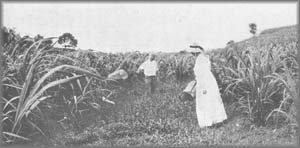 Shallow
Water and Low-Tide Collecting
Shallow
Water and Low-Tide CollectingCollection Procedures
 Shallow
Water and Low-Tide Collecting
Shallow
Water and Low-Tide Collecting
This work took place practically everyday. At times there were only three or so members participating but on some days there were as many as ten. The assignments were rotated between members of the expedition. This group was assigned the job of collecting specimens for the laboratory, both for work done in Barbados-Antigua and for future collections in the University. Those who collected worked under the expertise of Dr. Stoner whose task was to make sure everything worked smoothly and all specimens were in proper shape.
Row-Boat Parties
 |
 |
 |
This party, under the direction of Albert Ashby, worked near the reefs and adjacent waters down to a depth of about ten fathoms. A water-glass was taken along to spot specimens under the water. They were then pointed out to Albert who immediately dove down to bring them up. This work was extremely interesting and also very successful. The result was a number of fine specimens especially corals for both study and collection. Later in the expedition after Albert had become an expert collector, he was sent out by himself with a couple of boatmen to bring back whatever was needed. Sometimes the row-boat parties would go out with a small dredge so that a depth of about thirty fathoms could be explored. The boats also went to other coasts and engaged in shallow water diving and beach collecting.
Dredging
Dredging with the launch enabled a depth of 150 fathoms to be explored. Nutting and Henderson often took charge of this task on alternating days. They were accompanied by a few other members of the expedition who generally were so persistently seasick that they were eventually excused from this job and assigned elsewhere. Eventually, this resulted in the majority of the dredge work being done by Greenlaw, Henderson, Thomas, Miss Sykes, Wehman, and Nutting. The dredging parties frequently returned to the island soaked either by the spray or by the daily rain falls. Sometimes the dredge would become "hung up" on the bottom when the sea was high which occasionally made this work somewhat dangerous. 100 stations were dredged off the western and southern coasts of Barbados but due to the trade winds dredging was impossible on the eastern and northern coasts.
Land Parties
These almost exclusively consisted of Henderson, who was after land mollusks and was sometimes accompanied by Miss Sykes; Mr. and Mrs. Stoner, entomologists, and Professor Thomas, the geologist of the expedition. All of these teams were documented as doing good work and securing many specimens for later study and collection. Land work was also done by Mr. Ricker who served as the photographer of the expedition. He often went ashore by himself and wandered around which resulted in an excellent pictoral representation of urban and rural life. In addition to photographs a number of movies were also taken depicting various activities around the islands (to date these movies have not been found).
 Laboratory
Work
Laboratory
Work
Dr. Job was in charge of laboratory work and made constant use of the facilities arranged for the expedition. Studies of live organisms as well as dissection was done. There was almost a constant flow of specimens due to the daily collecting which resulted in a good deal of very interesting lab work. A "live car" was also used for the study of live sea-urchins. This was made of wire netting and stretched over a wooden frame which was then internally divided into compartments. Although it was very difficult to study the fish in this manner, the sea urchins proved a success.
Hauling of Fishpots
At least 4 fishpots were constantly in use during the expedition. They were anchored out near reefs and aided in obtaining a large collection of brilliantly colored and also edible reef fish. According to Charles Nutting (1919), "no flower bed nor collection of tropical butterflies could surpass the bright color of these fishes, and we all immensely enjoyed surveying the contents of the fishpot." Unfortunately preservation of the colors was impossible and faded very quickly and nothing in the preserved specimens indicated their real life appearances.